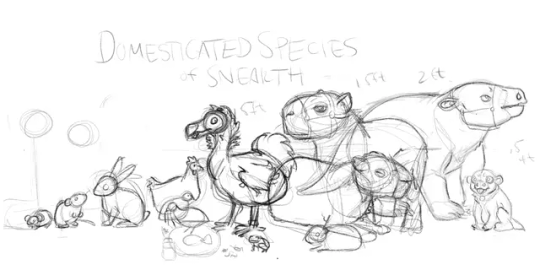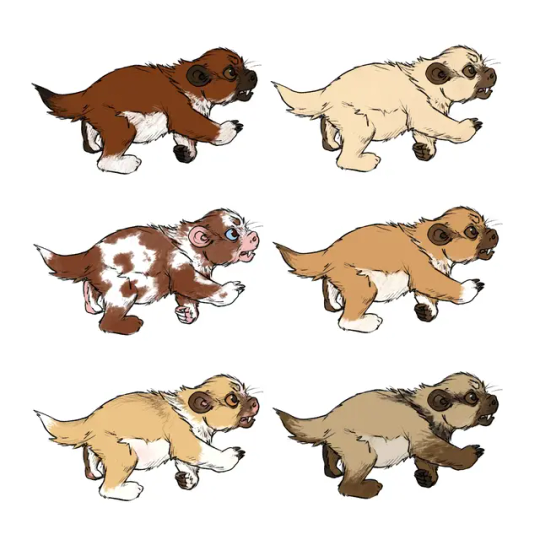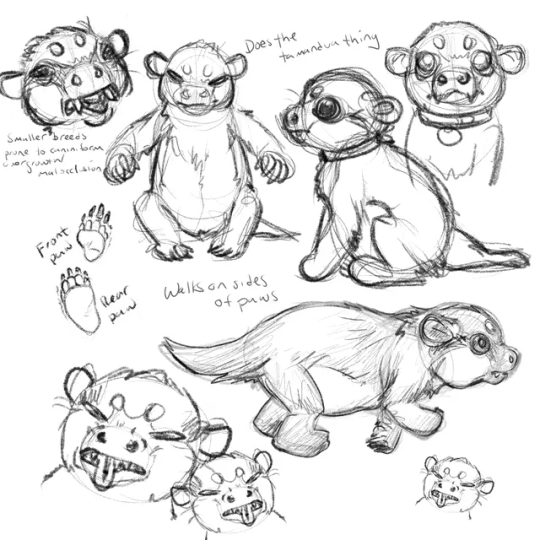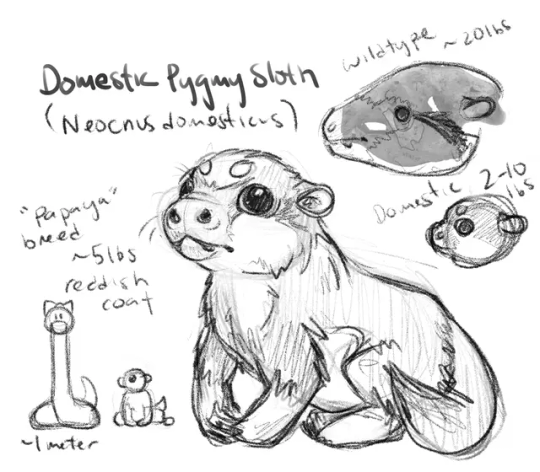Snake School is back in snession! Currently...worldbuilding!
Don't wanna be here? Send us removal request.
Text

POV: you are teaching your pygmy ground sloth how to sit
4 notes
·
View notes
Text

A Brooks Kingsnake classic!
#orochi high#reptiblr#webcomic#shoujo manga#snakes#boa constrictor#boa#capybara#blazing saddles#parody
8 notes
·
View notes
Text

Domesticated Species of Snearth
This is a list of the important domesticated animal species on Snearth. Other species are sometimes kept in captivity, but are not distinct enough from their wild counterparts to be considered domesticated.
Fancy Mouse (Mus domesticus)
-Domesticated from the house mouse (Mus musculus) approximately 10,000 years ago, possibly the first domestic species
-Larger than its wild relative with numerous coat types and colors
-Meat, leather, research, pet
Fancy Rat (Rattus snorvegicus domestica)
-Domesticated from the Snorwegian rat (Rattus snorvegicus) approximately 9,000 years ago
-Compared to the wild type, has numerous coat types and colors, ear and tail differences
-Meat, leather, research, pet
Coney (Oryctolagus cuniculus domesticus)
-Domesticated from the Eurepean rabbit (Oryctolagus cuniculus) approximately 5,000 years ago
-Several breeds with numerous coat types and colors, ear set differences, and body sizes.
-Meat, leather, fiber, research, pet
Chicken (Gallus gallus domesticus)
-Domesticated from the red junglefowl (Gallus gallus) approximately 8,000 years ago
-Compared to the wild type, has many different plumage types and colors, increased egg-laying ability
-Meat, eggs, feathers, pest control
Snapanese Quail (Coturnix snaponica)
-Domesticated from the wild Snapanese quail (Coturnix snaponica) approximately 1,000 years ago
-Not considered a separate species from the wild type, but shows some changes in plumage color and increased egg-laying ability
-Meat, eggs, feathers, pest control
Button Quail (Synoicus chinensis)
-Domesticated from the wild king quail (Synoicus chinensis) approximately 1,000 years ago
-Not considered a separate species from the wild type, but shows some changes in plumage color and increased egg-laying ability
-Meat, eggs, feathers, pest control
Goldfish (Carassius auratus)
-Domesticated from the crucian carp (Carassius carassius) approximately 1,500 years ago
-Smaller than its wild relative with different colors and fin and eye shapes
-Meat, pet
Domestic Dodo (Raphus cucullatus domesticus)
-Domesticated from the wild dodo (Raphus cucullatus) approximately 1,500 years ago
-Shorter and more gracile than its wild ancestor with changes in plumage and increased egg-laying ability
Eggs, feathers, mount, pack, guarding, pet
Squamerican Toad (Anaxyrus squamericanus)
-Domesticated from the wild Squamerican toad (Anaxyrus squamericanus) approximately 1,000 years ago
-Not considered a separate species from the wild type, but is larger with various color morphs
-Meat, research, pet
Woolly Capybara (Neochoerus lagotricha)
-Domesticated from the lesser northern capybara (Neochoerus aesopi) approximately 7,000 years ago
-Somewhat smaller than the wild ancestor with a thick, woolly coat. Several different coat colors and textures.
-Milk, leather, fiber, pack, pet
Saddle Capy (Hydrochoerus domesticus)
-Domesticated from the greater southern capybara (Hydrochoerus hydrochaeris) approximately 7,000 years ago
-Somewhat smaller than the wild ancestor with a more gracile build, tougher hooves, and reduced toe webbing. Several breeds with numerous coat colors.
-Mount, leather, draft, pack, pet
Slox (Parocnus domesticus)
-Domesticated from the lesser ground sloth (Parocnus dominicanus) approximately 8,000 years ago
-Somewhat smaller than the wild ancestor with a stockier build. Several breeds with numerous coat colors.
-Milk, mount, leather, draft, pack, guarding, pet
Domestic Pygmy Ground Sloth (Neocnus domesticus)
-Domesticated from the wild pygmy ground sloth (Neocnus comes) approximately 8,000 years ago
-Significant physical and behavioral changes. Much smaller than the wild ancestor with a shorter snout and, unusual for a domestic species, a larger braincase. Several breeds with numerous coat types and colors.
-Guarding, guiding, scenting, pet
Various invertebrates, notably the honeybee (Apis mellifera), mealworm (Tenebrio molitor), superworm (Zophobas atratus), dubia roach (Blaptica dubia), house cricket (Acheta domesticus), and burgundy snail (Helix pomatia) have also been cultivated as food in captivity for centuries, though they do not differ significantly from their wild ancestors.
#orochi high#reptiblr#webcomic#shoujo manga#snakes#sloth#sloths#ground sloth#giant ground sloth#domestication#life on snearth#chicken#dodo#capybara#goldfish#rat#mouse#rabbit#toad#quail#guinea pig#pets#worldbuilding
4 notes
·
View notes
Text


More domesticated animal friends for our snapient squamates!
#orochi high#reptiblr#webcomic#shoujo manga#sketches#worldbuilding#life on snearth#ground sloth#sloth#sloths#dodo bird#dodo#wip
3 notes
·
View notes
Text

A Quick Guide to the Domestic Pygmy Ground Sloth (Neocnus domesticus)
-First domesticated around 8000 years ago by the indigenous sneoples of the Snaribbean, these friendly mini-sloths are popular household pets. They were originally domesticated for their warmth during cold nights, though their primary purpose now is companionship.
-Domesticated from the wild pygmy ground sloth (Neocnus comes), a species still present in Hisspaniola. The wild species is semi-arboreal, weighs around 10 kg, and has a longer skull with a relatively smaller braincase. The teeth and tongue are often stained black due to its high-tannin folivorous diet.
Neocnus domesticus stats:
12-15 cm tall at the shoulder
1-4 kg
Lifespan 30-40 years
-Sows (females) are slightly larger than boars (males). Juveniles are called slothlets.
-Walks on the sides of its feet. Fore- and hind paws have five toes with long claws - the outer claws are absent.
-Several breeds, including Papaya, Coconut (a long-haired version of the papaya), Old Hisspaniolan, and Squamerican Hairless. Papaya is the most common breed in Snapan.
-The Papaya is a popular medium-sized breed averaging 2.5 kilograms and 13 cm tall. It has short fur and a brachycephalic head and is known for being more intelligent and biddable than other breeds. It has a long lifespan and is generally healthy, but is prone to malocclusion and crowding of the teeth.
-There are six accepted coat colors:
1. Dhole - Named after its resemblance to the wild Snasian canid. Dark chocolate paws and skin and black claws with dark brown eyes.
2. Cream - A solid cream sloth with chocolate paws, skin, and claws with dark brown eyes. The most common coat color.
3. Skewbald - White markings on any accepted color base. May have pink or spotted paws and skin, white or black claws, and dark brown or blue eyes.
4. Red Jackal - A lighter version of the dhole coloration with chocolate paws and skin, black claws, and dark brown eyes.
5. Golden Boy - Named in memory of the breeder's favorite sloth, a light golden coat with white socks and tail tip, chocolate or spotted paws and skin, chocolate claws, and light brown eyes. Faded wild type markings are sometimes present.
6. Wild Type - A coat color that resembles the wild pygmy ground sloths that still roam the Snaribbean. Dark eye and shoulder stripes with chocolate points and skin, black claws, and dark brown eyes.
-Owners must provide their pets with enrichment that stimulates the digging and climbing instincts and keeps the claws short. Most can be trained to use a litterbox and perform simple tricks.
-High quality kibble diets are available, but should be supplemented with fresh vegetables and greens.
#orochi high#webcomic#shoujo manga#sloth#sloths#ground sloth#neocnus#pilosans of the caribbean#life on snearth#worldbuilding#paleoart#sort of
17 notes
·
View notes
Text

These are the six accepted colors of the papaya breed of pygmy ground sloth. Which one is your favorite?
1. Dhole - Named after its resemblance to the wild Snasian canid. Dark chocolate paws and skin and black claws with dark brown eyes.
2. Cream - A solid cream sloth with chocolate paws, skin, and claws with dark brown eyes. The most common coat color.
3. Skewbald - White markings on any accepted color base. May have pink or spotted paws and skin, white or black claws, and dark brown or blue eyes.
4. Red Jackal - A lighter version of the dhole coloration with chocolate paws and skin, black claws, and dark brown eyes.
5. Golden Boy- Named in memory of the breeder's favorite sloth, a light golden coat with white socks and tail tip, chocolate or spotted paws and skin, chocolate claws, and light brown eyes. Faded wild type markings are sometimes present.
6. Wild Type - A coat color that resembles the wild pygmy ground sloths that still roam the Snaribbean. Dark eye and shoulder stripes with chocolate points and skin, black claws, and dark brown eyes.
#orochi high#reptiblr#webcomic#shoujo manga#life on snearth#ground sloth#sloth#sloths#neocnus#pilosans of the caribbean
9 notes
·
View notes
Text

This poor dumb creature is gonna be snomebody's pet. Haven't decided who gets to be the lucky owner yet!
12 notes
·
View notes
Text

Meet snakekind's best friend: the pygmy sloth!
First domesticated around 8000 years ago by the indigenous sneoples of the Snaribbean, these friendly mini ground sloths are popular household pets.
There are several breeds, including the papaya, a mid-sized (~5 pounds) brachycephalic breed with a reddish coat.
#orochi high#reptiblr#webcomic#shoujo manga#snake#snakes#sloth#sloths#life on snearth#domestication#worldbuilding#ground sloth#neocnus#sketches#brachycephalic
10 notes
·
View notes
Text

Happy Hachi!
#orochi high#hachi#hatchi#bumblebee ball python#ball python#python#spider ball python#reptiblr#webcomic#shoujo manga#snakes#snake#sketches
9 notes
·
View notes
Text




Various Juns.
10 notes
·
View notes
Text

Bad Boi or Sad Boi? Remains to be seen.
4 notes
·
View notes
Text


Is that...a smile?

Nope. False alarm.
8 notes
·
View notes
Text
First snappearance of the sneksona
An excerpt from the Snictionary (snake dictionary), specifically from its extensive "S" snection:
Snakefriend - snake SO
Snakekind - snake mankind
Snakeup - snake makeup
Snanga - snake manga
Snapient - snake sapient
Snaracter - snake character
Snaraoke - snake karaoke
Snarcade - snake arcade
Snarent - snake parent
Snart - snake art; alternatively, snake fart
Snartist - snake artist
Snashion - snake fashion
Snastronaut - snake astronaut
Snath - snake math
Snearth - snake Earth
Sneaven - snake Heaven
Snekcessories - snake accessories
Sneklace - snake necklace
Snelfie - snake selfie
Snell - snake Hell
Snenbei - snake senbei
Snera - snake era
Snerd - snake nerd
Snero/sneroine - snake hero/heroine
Snerson/sneople - snake person/people
Snibling - snake sibling
Snience - snake science
Snientist - snake scientist
Snivilization - snake civilization
Snomebody - snake somebody
Snomeone - snake someone
Snourists - snake tourist (not always snakes)
Snudent - snake student
Snupport - snake support
Snurgatory - snake Purgatory
57 notes
·
View notes
Text
BOOMSLANG, SNAYINGS and SNIDIOMS (Snake Slang, Sayings and Idioms)
The following in a selection of common boomslang, snayings and snidioms from the Snurban Snictionary (snake Urban Dictionary):
Snoot - snout, also a mild expletive (like “shoot!”)
“What the snek?” - what the heck
Hissin’, hiss off, etc. - snake F-bomb, p*ss off
“That kinks my tail” - that frustrates/annoys me
“Keep at tail’s length” - keep at arm’s length
“Tail it over” - hand it over
Tail-holding - hand-holding for snakes
Slither - snake walk
Crawl - snake walk
“Crawl a mile in snomeone’s scutes” - walk a mile in someone’s shoes
Scute - walk/move along “Scute off!” and “Scute along.” Also the belly scales of a snake/their “feet”
(Note: “Hand” or “foot” in any snaying/snidiom should be replaced with “tail” or “scute”)
“Mice to meet you” - nice to meet you
Cloac/cloaca - A**hole, p*ssy. i.e. “Don’t be a cloac!”
Pene (as in “hemipene”) - d*ck
In blue - in the process of shedding. Shedding the skin is an exhausting week-long process for snakes. Sneople typically take the day off when fully “in blue,” as their eye caps are clouded over and they are temporarily blind.
Stuck shed/bad shed - An unsuccessful shed where a few pieces of dried skin remain on the body. Comparable to bad acne and seen (incorrectly) as unhygienic.
Regurge/regurgitate - to vomit/be sick. Sometimes shortened to “gurge” or just “puke.”
Hugger - slang for a non-venomous snerson, especially a constrictor. Can be positive/neutral or negative depending on use.
Hot - slang for a venomous snerson. Positive, typically one venomous snerson to another.
Nox/noxes - from “noxious,” slur for a venomous snerson.
(Regarding Venom: it’s kind of going the way of the wisdom tooth in venomous species. Comes in like puberty in tween/teen snakes, but not all snakes get their venom in and some get it in partially or late.
The toxicity of venom has decreased a lot since the dawn of snivilization. It is no longer strong enough to kill another snake, though it can make them sick or pass out. It can kill lizards and small mammals, though, especially in high doses.)
Spicy - a snerson whose venom has come in. “Are you spicy yet?” Shokupan ("milk bread") - an adult venomous snerson without venom. Not a nice thing to call snomebody. V-banks - Venom banks for venom donation, similar to blood banks. Venomous sneople have different “V-types.” Snake venom is used in the making of many life-saving medications.
Hatchling/hatchie - a baby snake, used by both egg-laying and ovoviviparous species
Hatchday - snake birthday
Juvi - a young/teen snake
“The Missing Skink” - the Missing Link, last common ancestor of snakes and lizards
7 notes
·
View notes
Text


Is it weird to be a fan of your own snaracter?
I just want this guy to be happy and successful. I hope he makes team captain!
#orochi high#yakamashii#western diamondback rattlesnake#diamondback rattlesnake#rattlesnake#reptiblr#webcomic#shoujo manga#snakes#sketches
7 notes
·
View notes
Text
Happy Pride from Orochi High! Stay safe out there, everyone.
O-Hi has one token straight snaracter. Can you guess who it is?

Snake School is Back in Snession!
Here’s the new and improved Orochi High snaracter lineup! A few things have changed (They’re sneniors! O-Hi is in Snokyo now! There’s a new guy!), but for the most part, they’re the same old snaracters you fell in love(?) with seven years ago. Enjoy, and keep those snoots astute. The best is yet to come!
Updated snaracter descriptions below:
Truffle Amaguchi
Species: Ball Python (Silver Bullet Morph)
Length: 0.7 meters
Age: 18
Truffle Amaguchi is an ordinary girl starting her final year at Orochi High. She was born in Osnaka and moved with her mom and little brother to Snokyo two years ago.
Truffle is a romantic with very little real-life experience. She loves reading shoujo snanga, and has somewhat unrealistic expectations as a result. Her hobbies are reading, collecting bones and natural hisstory items, and going to the museum. Truffle does well in school, but has been struggling recently, putting her university hopes in jeopardy.
Truffle’s favorite snekcessory is a cute red bow with a mouse skull in the middle. She has a tiny kink on the tip of her tail.
Mochi Shinda
Species: Western Hognose (Wild Type)
Length: 0.5 meters
Age: 17
Mochi Shinda is a short Western hognose who was Truffle’s first friend at Orochi High. A mischievous prankster, she comes off as a bit insensitive but cares more than she lets on. She has been known to play dead to get out of unpleasant situations (like gym class).
Mochi enjoys cooking for her five younger sniblings and inventing new dessert recipes.
Mochi always wears a cool spiked taillet.
Marzipan Ono
Species: Burmese Python (Hypomelanistic Morph)
Length: 4.5 meters
Age: 18
Marzipan Ono is a big girl with big headboobs and an even bigger heart. Soft-spoken and shy, she does her best to stay out of the way but inadvertently causes accidents and injuries because of her size. Marzipan loves animals and has a pet bunny named Minchi. She volunteers at the local zoo. Her favorite animal to work with is Meg the giant ground sloth, who is currently pregnant and expecting a calf soon!
She wears a tiny pink bow on her tail at all times.
Atheris Hispida
Species: Hairy Bush Viper (Wild Type)
Length: 1 meter
Age: 18
The mysterious, venomous Atheris Hispida has always counted on his “tough guy” status to keep sneople at tail’s length, but when Truffle stumbles (literally) upon his deepest secret, he fears his reputation is at stake!
He wears his tie loose because he thinks it makes him look cool (it does).
Nise Ashinashi
Species: “Kingsnake”
Length: 2 meters
Age: 19
Not much is known about secretive new transfer snudent Nise Ashinashi. He moved to Snokyo from Nagasnaki and he comes from a wealthy kingsnake family, but that’s about it. Nise keeps his cards close to his…neck? Or is he more tail? He has a distrust bordering on prejudice towards venomous species, though he is warming up to Yakamashii.
Whatever you do, don’t steal his beanie, no matter how tempting it is. Ever.
Yakamashii Ogoe
Species: Western Diamondback Rattlesnake (Wild Type)
Length: 1.2 meters
Age: 18
Loud, outgoing, and sometimes annoying, Yakamashii Ogoe is nevertheless Atheris’s closest friend. They grew up together in the same neighborhood and bonded over shared experiences (and tastes in video games).
Despite carrying a nasty hemotoxin in his fangs, Yakamashii is mostly harmless. He excels at sports and hopes to become captain of Orochi High’s successful Koudo ( 絞道 - "Way of the Wrap") team this year.
The O-Hi tail band he wears shows off his school spirit!
Monoko Mori
Species: Monocled Cobra (Albino Morph)
Length: 1.5 meters
Age: 19
Regarded as the most beautiful girl at Orochi High, Monoko Mori has many admirers. Despite being confessed to on an almost daily basis, she has turned down every single suitor so far. Though she is not unkind, her quiet demeanor and disinterest in dating have earned her the reputation of being cold.
Her striking albino coloration, while attractive to many, makes her sensitive to light and susceptible to sunburn, so she is often forced to limit outdoor activities.
Her hood piercing stands in stark rebellion against her otherwise pristine appearance.
Hachi Mitsu
Species: Ball Python (Bumblebee Morph)
Length: 0.8 meters
Age: 18
Unlike most of his peers, Hachi Mitsu seems to have it together. He knows what he wants to be when he grows up (video game designer), and he knows what he’s got to do to do it (get good grades and make it into the prestigious Snokyo Institute of Technology). He and Marzipan become fast friends after he offers to tutor her in snath.
He has a neurological condition called “the wobble,” which he inherited from his dad’s side of the family. He’s pretty good with a power chair, though–just watch your tail!
Hatchi has contacts, but prefers to wear glasses at school because he thinks they make him look smart.
Jun Aoki
Species: Emerald Tree Boa
Length: 1.2 meters
Age: 18
Jun is a striking emerald tree boa that lives with their grandmother in an apartment building near the coast. At school, they usually keep to themselves, doodling in the margins of their homework or painting elaborate landscapes in Creative Club after class. Most snudents consider them unusual and intimidating, but few have taken the time to really get to know them.
They enjoy collecting shells with their grandma and keep their favorite, a beautiful textile cone, on a cord around their neck.
#orochi high#truffle#mochi#marzipan#atheris#hispida#yakamashii#nise#monoko#hachi#jun#snakes#reptiblr#shoujo manga#happy pride 🌈
56 notes
·
View notes
Text
Snay - snake gay

(He's projecting)
An excerpt from the Snictionary (snake dictionary), specifically from its extensive "S" snection:
Snakefriend - snake SO
Snakekind - snake mankind
Snakeup - snake makeup
Snanga - snake manga
Snapient - snake sapient
Snaracter - snake character
Snaraoke - snake karaoke
Snarcade - snake arcade
Snarent - snake parent
Snart - snake art; alternatively, snake fart
Snartist - snake artist
Snashion - snake fashion
Snastronaut - snake astronaut
Snath - snake math
Snearth - snake Earth
Sneaven - snake Heaven
Snekcessories - snake accessories
Sneklace - snake necklace
Snelfie - snake selfie
Snell - snake Hell
Snenbei - snake senbei
Snera - snake era
Snerd - snake nerd
Snero/sneroine - snake hero/heroine
Snerson/sneople - snake person/people
Snibling - snake sibling
Snience - snake science
Snientist - snake scientist
Snivilization - snake civilization
Snomebody - snake somebody
Snomeone - snake someone
Snourists - snake tourist (not always snakes)
Snudent - snake student
Snupport - snake support
Snurgatory - snake Purgatory
57 notes
·
View notes